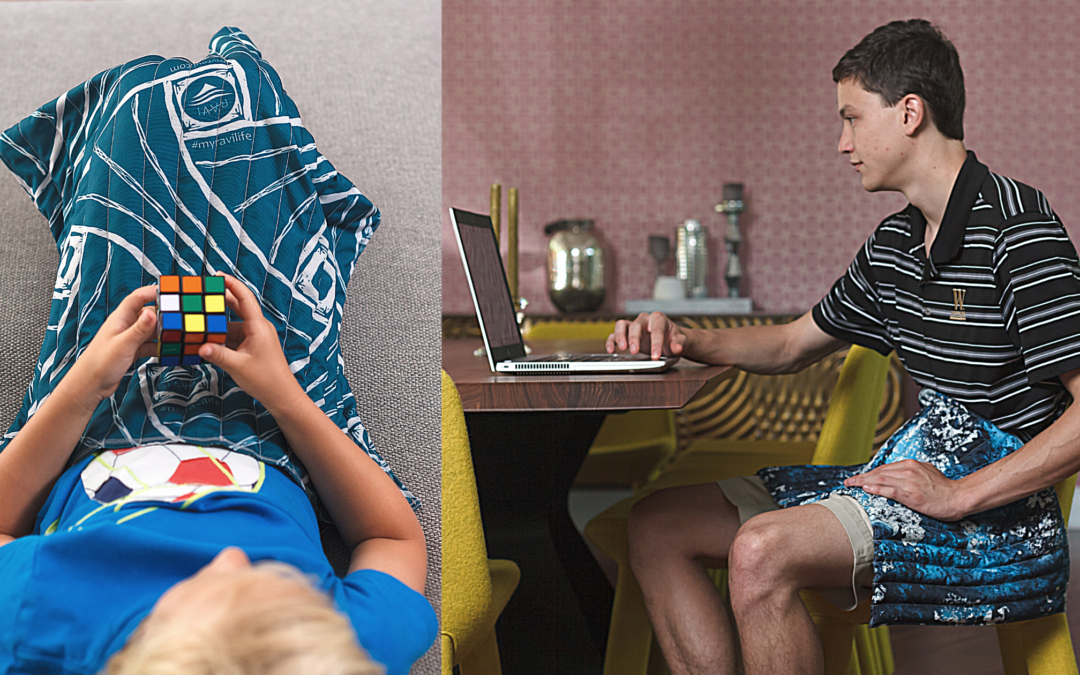The weighted blanket helps with focus and concentration.
Pressure on the body from a weighted blanket helps focus through Deep Pressure stimulation. Deep pressure stimulates the parasympathetic nervous system which helps regulate and optimize the body function for day to day tasks. It is also known as the Rest and Digest or the Feed and Breed system.
‘
The sensation of the weighted blanket is like a hug.
Comforting and calming. RAVI is a Hug wrapped up in a blanket.

Penn Medicine Health Article on Weighted Blankets
“It’s easy to become frustrated when you’re trying to concentrate but just can’t. This can lead to stress and irritation, which tends to make focusing on what you need to do even more of a distant dream.”
Concentration and focus:
There are several things you can do to create environments that support concentration and focus for adults and children.
Remove or tune out distractions
Remove or tune out distractions
Get good sleep, exercise and diet
Practice concentration
Practice Meditation
Set time for play and for focus
Practice concentration
Practice Meditation
Set time for play and for focus
How and When to Use a Weighted Lap Pad for Concentration and Calming
Here is an article written by Alisha Grogan (licensed occupational therapist and founder of Your Kid’s Table.)
Alisha offers a strategy she uses to decide if weighted lap pads may be helpful for a child:

- Does the child have difficulty sitting still for organized activities?
- Does the child have difficulty sitting still for any activity?
- Does the child have difficulty transitioning between activities (i.e. time to go to the store, time to take a bath, etc.)
- Does the child have difficulty being in public or social settings?
- Does the child have difficulty going to sleep?
- Does the child have anxiety or difficulty relaxing?
- Does the child seem to seek out rough or wild playing like jumping, climbing, or deep pressure in some way on their body?
If you answered yes to any of the questions, then we need to take it a step further:
- Does the child have tactile defensiveness and doesn’t like objects or fabrics like bed sheets being on them?
- Does the child seem to shy away from heavy objects, jumping activities, or seem lethargic or apathetic often?
If you answered yes to either of these questions, especially the latter, then this sensory hack may not be a good fit for your child.
She also suggests some use for weighted lap pads:
- Mealtimes (for the kids that keep falling out of their chair, fidgets constantly, or is always get up out of their seat)
-
Learning activities (puzzles, school activities that must be completed at a desk, coloring, etc.)
-
Circle time at school, daycare, or the library (for kids that keep getting up, rolling over, or are disruptively fidgety)
-
In the car (for the kid that hates car rides or is anxious about going somewhere)
-
When changing activities (for the kid that tantrums and melts down when it’s time to do something different, they can carry it or wrap it around their neck)
-
During haircuts (for the kid that is irritated by the buzzers, scissors, or flying hair)
-
When cutting nails (for the kids that screams and has a major meltdown)
-
For teeth brushing (for the kid that can’t stand it, have them sit with it on their lap, let them hold it, or wear it around their neck)
-
In social settings like birthday parties with crafts and sit down activities
-
In the grocery cart (for kids that are overwhelmed by the lights, sound, or environment of a store)
-
When playing in a sensory bin (for kids that don’t like to get messy, this can be calming input that helps them explore the texture of the sensory bin)
-
For bedtime/sleeping (for kids that have a hard time getting to sleep or falling asleep, allow them to hold or place it where it feels comfortable. But, not recommended for children under 3 during sleep)
-
In a quiet spot, a sensory tent, or while relaxing on the couch (for kids that have difficulty calming down or may be described as hyperactive.)



